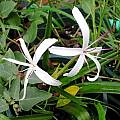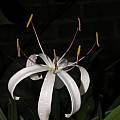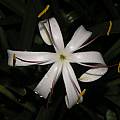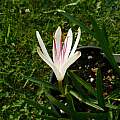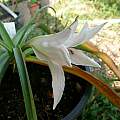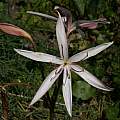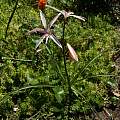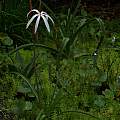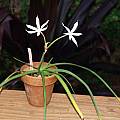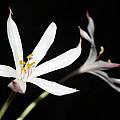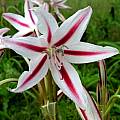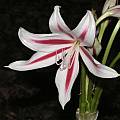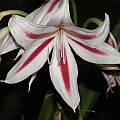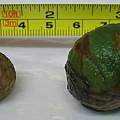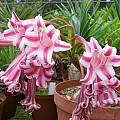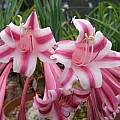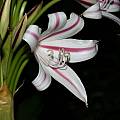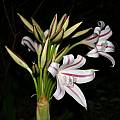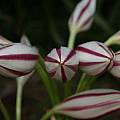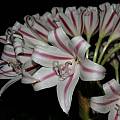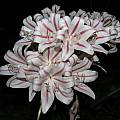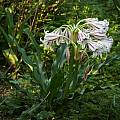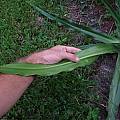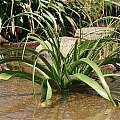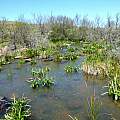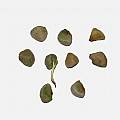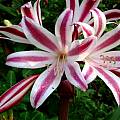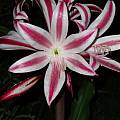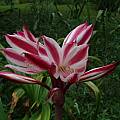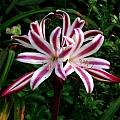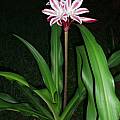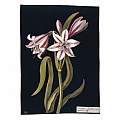Crinum species o-z are found on this wiki page.
Crinum Species a-b - Crinum Species c-j - Crinum Species l-n - Crinum Species Index - Crinum Hybrids Index
Crinum oliganthum Urb. is a small plant native to the Caribbean. Allied to Crinum americanum, it prefers damp growing conditions and spreads by rhizomes. When I bought this from Yucca Do Nursery, they called it Crinum sp. mini-americanum. It is also called 'West Indies mini' Crinum. Their pictures show six-petaled flowers, but these are only five-petaled. The plant is very small and is shown here growing in a 1 gallon container. Height range: 25-30 cm. The first photo taken August 2004 by Lee Poulsen & though not directly from them this plant originated from Yucca Do Nurseries; photos two and three taken summer 2006 by Alani Davis, and photo number four from Alessandro Marinello.
Crinum paludosum I.Verd. is native to South Africa, Botswana and Namibia. Height: 45 cm. Photo by Alessandro Marinello.
Crinum pedunculatum R.Br. see Crinum asiaticum.
Crinum procerum Herb. see C. asiaticum.
Crinum razafindratsiraea LehMill. is a species from Madagascar. Height range: 3-5 ft. The first three photos are by Alani Davis. The following two photos are from Uluwehi Knecht's plant grown in Honolulu, Hawai`i. The blooms open slightly at dusk and only fully once night has fallen. I was not able to detect a scent at the time, and the flowers only last one night. The terra cotta pot it was growing in was approx 8 cm wide.
Crinum scabrum Herb. is considered in 2021 to be a synonym of Crinum ornatum (Aiton) Herb. which is native from Tropical Africa to Namibia. Text and photos below written at an earlier time. It is a form surrounded with much mystery to its history. Seeming to have originated from an African heritage, it is not known to occur there and where exactly it originated is not clear. Originally it was described from material collected in Rio de Janeiro and its occurrences in the southeast United States and the scattered in the Caribbean as well are areas historically associated with the slave trade. I have had several anecdotal discussions about the medicinal and ethnobotanical uses of this plant and I have often wondered if this was not just a horticultural selection, possible of hybrid origins, which has the useful reproductive characteristic of readily offsetting which many native and wild forms are reluctant to do. It has nicely scented white flowers with red stripes which encourage its growth for mere garden reasons as well which is the reason it is typically grown today. Height range: 75 cm. Photos by Alani Davis & Michelle Davis. Final photo of seed of Crinun scabrum on the left and Crinum jagus by David Pilling.
Crinum stuhlmannii Baker grows naturally in the warm coastal areas of KwaZulu-Natal and is closely allied to C. graminicola. It was a great surprise when this plant flowered in our collection for the first time in 2008. This large bulb was rescued from a Durban herbalist market where hundreds of tons of similar plant (and animal) material is illegally harvested and sold annually. It has two subspecies: Crinum stuhlmannii ssp. delagoense (I.Verd.) Kwembeya & Nordal and Crinum stuhlmannii ssp. stuhlmannii. Height: to about 1 m. Photos by Rogan Roth.
Crinum sp. was sold as by an African plant importer as C. graminicola which it is not, but I am not sure what it is. Any ideas anyone? The buds on each 50 cm scape open nearly all at one time on the same night with just a few buds opening the night before or the night after. The flowers only last one night & are wilting by dawn the morning after. I have self pollinated all the flowers but have never gotten any seed. The glossy medium green leaves form a low spreading rosette of foliage. Photos by Alani Davis.
Crinum variabile (Jacq.) Herb. grows on rocky or sandy seasonally streambeds from the northwest Cape to the western Karoo. Plants grow from 40 to 60 cm high and form clumps. Flowers are white to pale pink with deeper pink or green keels and are heavily scented. In the wild it blooms between January and May. It doesn't mind summer water in cultivation, and tends to bloom better when grown in large pots or in the ground. The first two photos were taken in habitat on the road to Studer's Pass, Kamiesberg in Namaqualand by Andrew Harvie. The third photo was taken by Cameron McMaster near Nieuwoudtville September 2011. The last photo by Nhu Nguyen shows seeds, one of which has already sprouted.
Crinum zeylanicum (L.) L. is native to western India and Sri Lanka. It has very showy red and white striped flowers, but is tender and needs protection from cold weather. Will grow to at least zone 8b. It is often confused with the Crinum scabrum, however it is quite distinct in several ways. It has a prominent whitish rib on the underside of the leaf which is prominent on several of its hybrids as well. The scapes, peduncles, seed pods, and buds are burgundy and the scape also has a glaucous coating as well giving it a distinctive purplish appearance. Also note the attenuated tip to each tepal especially evident on the photos of the just open flowers. Height range: 3-5 ft. Photos by Alani Davis.
A paper collage called "Crinum zeylanicum: Asphodil Lilly", made in England in 1778 by Mary Delany who began making her 'mosaicks', at the age of 72. © Trustees of the British Museum.
Crinum Species a-b - Crinum Species c-j - Crinum Species l-n - Crinum Species Index - Crinum Species Index - Crinum Hybrids Index
